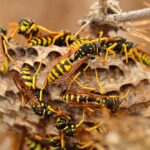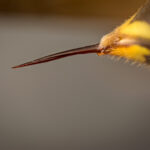How Can We Help?
How do wasps build their nests?
Wasps build their nests using a mix of chewed wood fibers and saliva, creating a lightweight and durable papery substance. The process usually kicks off with a fertilized queen emerging from hibernation in the spring; choosing a good location, she scrapes wood fibers from sources like fences, logs, or even cardboard, chews them, and mixes them with her saliva to make a pliable pulp.

Once the first workers are mature, they take over collecting wood fibers and expanding the nest. They continue gathering materials, chewing them into pulp, and adding new nest layers, creating more cells for the queen to lay eggs. This ongoing construction results in a multi-layered, intricate nest that can grow significantly throughout the season.
The nest's outer layers shield it from predators and the environment, while the inner cells house growing larvae. The design allows for efficient ventilation and temperature control, which is crucial for the colony's survival. The queen and worker wasps' joint effort keeps the nest sturdy and functional, supporting the colony's growth and reproductive success through the warmer months. By late summer or early autumn, the nest can house hundreds to thousands of wasps.
What are the key factors that influence wasp activity and nesting habits?
Several key factors shape wasp activity and nesting habits, such as environmental conditions, resource availability, and seasonal changes. Temperature is a major factor, with wasps being more active in warm weather. They typically come out of hibernation in the spring and start building nests as it gets warmer, peaking in activity during the summer. Cold weather, on the other hand, can limit their activity and make them seek shelter.
Food availability greatly influences wasp behavior, too. Wasps are omnivores and eat a variety of foods, including nectar, fruit, insects, and even human food waste. In the spring and early summer, they mainly hunt other insects to feed their protein-needing larvae. As the season goes on and the colony grows, adult wasps start looking for more sweet foods and carbs to keep their energy up.
Shelter and suitable nesting sites are crucial for wasp colonies. They prefer spots that offer protection from the elements and predators. Common nesting sites include tree branches, shrubs, attics, eaves, wall cavities, and underground burrows. The choice of nesting site can vary depending on the wasp species; for example, paper wasps often build exposed, umbrella-shaped nests, while yellow jackets and hornets might make enclosed nests in hidden or underground spots.
Seasonal changes also dictate wasp activity. During late summer and early fall, wasp colonies reach their peak size. At this time, the queen's egg-laying slows down, and worker wasps become more aggressive in their search for food. This period often coincides with increased human-wasp encounters, as wasps scavenge for food at picnics, outdoor events, and around rubbish cans.
Human activity can also affect wasp behavior and nesting. Food waste, sugary drinks, and unsealed garbage can attract wasps to urban and suburban areas. Reducing access to these attractants and keeping things clean can help manage wasp populations and minimize the risk of nests forming close to where people are.
Where do wasps most commonly build their nests?
Wasps tend to build their nests in spots that offer protection from the weather and predators, while also being close
Yellow jackets and hornets, however, tend to go for more hidden and protected areas. Yellow jackets often construct their nests underground in old rodent burrows or in hidden cavities like wall voids, attics, and crawl spaces. These nests are usually enclosed and can get pretty big, housing thousands of wasps by the end of the season. Hornets, especially European hornets, might build their nests in tree hollows, attics, sheds, and other sheltered spots. Their nests are also made from a paper-like material but are usually stronger and more enclosed than those of paper wasps.
In urban and suburban areas, there are tons of potential nesting sites for wasps. They might use man-made structures like the spaces under decks, inside garages, and the gaps in exterior walls. They're also attracted to places with lots of human activity where food is easy to find, such as outdoor dining areas, garbage cans, and compost bins.
Besides these structural sites, wasps also nest in natural environments. Tree cavities, rock crevices, and dense vegetation are all good nesting spots, especially for species that prefer more natural settings. The choice of nesting site is influenced by the need for security, closeness to food sources, and the environmental conditions that help the colony grow and survive. Here at Youngs Pest Control, we understand these preferences can help in spotting and managing wasp nests, reducing the risk of stings and infestations near where people live.
